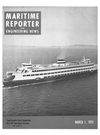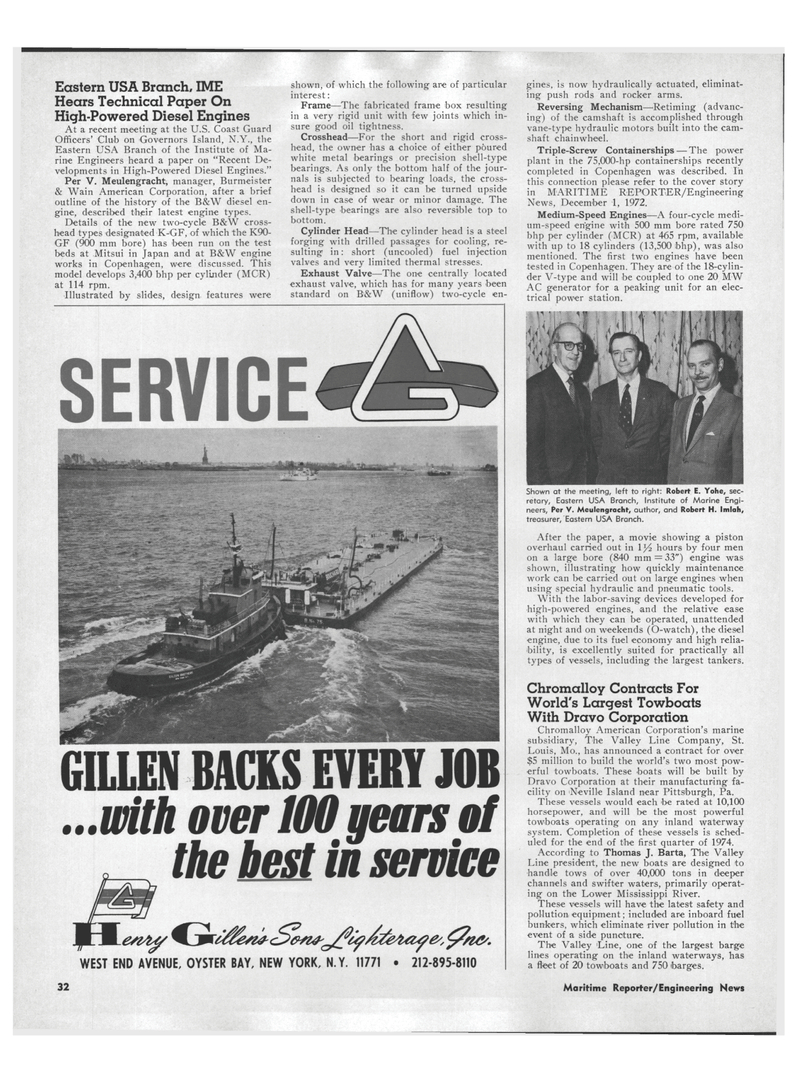
Page 24: of Maritime Reporter Magazine (March 1973)
Read this page in Pdf, Flash or Html5 edition of March 1973 Maritime Reporter Magazine
Eastern USA Branch, IME
Hears Technical Paper On
High-Powered Diesel Engines
At a recent meeting at the U.S. Coast Guard
Officers' Club on Governors Island, N.Y., the
Eastern USA Branch of the Institute of Ma- rine Engineers heard a paper on "Recent De- velopments in High-Powered Diesel Engines."
Per V. Meulengracht, manager, Burmeister & Wain American Corporation, after a brief outline of the history of the B&W diesel en- gine, described thjeir latest engine types.
Details of the new two-cycle B&W cross- head types designated K-GF, of which the K90-
GF (900 mm bore) has been run on the test beds at Mitsui in Japan and at B&W engine works in Copenhagen, were discussed. This model develops 3,400 bhp per cylinder (MCR) at 114 rpm.
Illustrated by slides, design features were shown, of which the following are of particular interest:
Frame—The fabricated frame box resulting in a very rigid unit with few joints which in- sure good oil tightness.
Crosshead—For the short and rigid cross- head, the owner has a choice of either poured white metal bearings or precision shell-type bearings. As only the bottom half of the jour- nals is subjected to bearing loads, the cross- head is designed so it can be turned upside down in case of wear or minor damage. The shell-type bearings are also reversible top to bottom.
Cylinder Head—The cylinder head is a steel forging with drilled passages for cooling, re- sulting in: short (uncooled) fuel injection valves and very limited thermal stresses.
Exhaust Valve—The one centrally located exhaust valve, which has for many years been standard on B&W (uniflow) two-cycle en- gines, is now hydraulically actuated, eliminat- ing push rods and rocker arms.
Reversing Mechanism—Retiming (advanc- ing) of the camshaft is accomplished through vane-type hydraulic motors built into the cam- shaft chainwbeel.
Triple-Screw Containerships—The power plant in the 75,000-hp containerships recently completed in Copenhagen was described. In this connection please refer to the cover story in MARITIME REPORTER/Engineering
News, December 1, 1972.
Medium-Speed Engines—A four-cycle medi- um-speed engine with 500 mm bore rated 750 bhp per cylinder (MCR) at 465 rpm, available with up to 18 cylinders (13,500 bhp), was also mentioned. The first two engines have been tested in Copenhagen. They are of the 18-cylin- der V-type and will be coupled to one 20 MW
AC generator for a peaking unit for an elec- trical power station.
Shown at the meeting, left to right: Robert E. Yohe, sec- retary, Eastern USA Branch, Institute of Marine Engi- neers, Per V. Meulengracht, author, and Robert H. Imlah, treasurer, Eastern USA Branch.
After the paper, a movie showing a piston overhaul carried out in 1 Yz hours by four men on a large bore (840 mm = 33") engine was shown, illustrating how quickly maintenance work can be carried out on large engines when using special hydraulic and pneumatic tools.
With the labor-saving devices developed for high-powered engines, and the relative ease with which they can be operated, unattended at night and on weekends (O-watch), the diesel engine, due to its fuel economy and high relia- bility, is excellently suited for practically all types of vessels, including the largest tankers.
Chromalloy Contracts For
World's Largest Towboats
With Dravo Corporation
Chromalloy American Corporation's marine subsidiary, The Valley Line Company, St.
Louis, Mo., has announced a contract for over $5 million to build the world's two most pow- erful towboats. These boats will be built by
Dravo Corporation at their manufacturing fa- cility on Neville Island near Pittsburgh, Pa.
These vessels would each be rated at 10,100 horsepower, and will be the most powerful towboats operating on any inland waterway system. Completion of these vessels is sched- uled for the end of the first quarter of 1974.
According to Thomas J. Barta, The Valley
Line president, the new boats are designed to handle tows of over 40,000 tons in deeper channels and swifter waters, primarily operat- ing on the Lower Mississippi River.
These vessels will have the latest safety and pollution, equipment; included are inboard fuel bunkers, which eliminate river pollution in the event of a side puncture.
The Valley Line, one of the largest barge lines operating on the inland waterways, has a fleet of 20 towboats and 750 barges.
SERVICE*^
GILLEN BACKS EVERY JOB ...with over 100 gears of the best in service
WEST END AVENUE, OYSTER BAY, NEW YORK, N.Y. 11771 • 212-895-8110 32 Maritime Reporter/Engineering News

 23
23

 25
25
